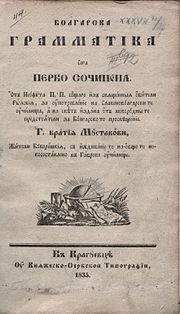Neofit Rilski
This article has multiple issues.Please helpimprove itor discuss these issues on thetalk page.(Learn how and when to remove these messages)
|
Neofit Rilski Неофит Рилски | |
|---|---|
 | |
| Born | Nikola Poppetrov Benin Никола Поппетров Бенин 1793 |
| Died | January 4, 1881(aged 87–88) |
| Nationality | Ottoman, Bulgarian |
| Occupation(s) | monk,artist,translator |
| Known for | Translating the first Bible into vernacularBulgarian |


Neofit Rilski(Bulgarian:Неофит Рилски) orNeophyte ofRila(bornNikola Poppetrov Benin;[a]1793 – January 4, 1881) was a 19th-centuryBulgarianmonk, teacher and artist, and an important figure of theBulgarian National Revival.[1]
Biography
[edit]He was born in the southwestern town ofBansko(or possibly in the village ofGuliyna Banya) ofPirin Macedonia.[2]Benin was educated to become a teacher, initially by his father Petar, and later at theRila Monastery,where he studied iconography and had access toGreekandChurch Slavonicbooks. He went toMelnikin 1822, where he spent four years as a student of the noted teacher Adam and perfected his Greek andGreek literatureknowledge. Initially working as a teacher in the Rila Monastery, he also spent time working inSamokov(1827–1831), then back in the monastery, then went toGabrovoandKoprivshtitsa(1835–1839) and returned to the monastery as a teacher to join thetheological schoolon the island ofHalki,where he spent four and a half years. He returned to the Rila Monastery in 1852. He spent the remaining part of his life in Rila, and since 1860 was the monastery'shegumen.He stayed in the monastery despite being offered higher positions in the Orthodox hierarchy, such as becoming a bishop or the rector of the projectedTarnovoseminary.
In 1835, Rilski issued hisBolgarska gramatika,the first grammar book ofmodern Bulgarian language.[3]His other books includeTablitsi vzaimouchitelniand the 1852 Greek-SlavicdictionarySlovar greko-slavyanskiy.Neofit Rilski made the first populartranslation of the New Testament in modern Bulgarian language(not a mixture between Church Slavonic and vernacular elements), commissioned, edited and distributed by theAmericanmissionaryElias Riggs.[3][4][5]Rilski consideredOld Church Slavonicas synonymous withOld Bulgarianand he tried to unify Western and EasternBulgarian dialects.[6]
Neofit Rilski died in theRila Monasteryon 4 January 1881.
Neofit PeakonSmith Island,[7]South Shetland IslandsandSouth-West University "Neofit Rilski"inBlagoevgradare named after Neofit Rilski.
Notes
[edit]References
[edit]- ^Buchan, John,ed. (1924)."Bulgaria".Bulgaria and Romania: The Nations of Today; A New History of the World.Boston and New York: Houghton Mifflin Company. p.30.Retrieved21 June2021– viaInternet Archive.
- ^MacDermott, Mercia(1962).A History of Bulgaria 1395–1885.New York: Frederick A. Praeger. p.130.Retrieved18 June2021– viaInternet Archive.
- ^abBourchier, James David(1911)..InChisholm, Hugh(ed.).Encyclopædia Britannica.Vol. 04 (11th ed.). Cambridge University Press. pp. 784–786, see page 786.
With the multiplication of books came the movement for establishing Bulgarian schools, in which the monk Neophyt Rilski (1793–1881) played a leading part. He was the author of the first Bulgarian grammar (1835) and other educational works, and translated the New Testament into the modern language
- ^Wiener, Leo(February 1898). "America's Share in the Regeneration of Bulgaria (1840-1859)".Modern Language Notes.13(2): 36–37.doi:10.2307/2918140.JSTOR2918140.
- ^Georgi Genov.American Elias Riggs and his contribution to the Bulgarian National RevivalArchived2008-05-03 at theWayback Machine.Historical Archives.Sofia, Issue 9-10, November 2000 - May 2001 (in Bulgarian).
- ^Discourses of collective identity in Central and Southeast Europe (1770–1945) Page 248by Balazs Trencsenyi, Michal KopecekISBN963-7326-52-9
- ^"Neofit Peak",SCAR Composite Gazetteer of Antarctica,retrieved1 September2018
Literature
[edit]- Olesch, R. (ed.): Neofit Rilski, Bolgarska grammatika. Kragujevac 1835. Tablici Bukarest 1848. Unveränderter Nachdruck mit einer Einleitung herausgegeben von Reinhold Olesch (Slavistische Forschungen, Bd. 41). Köln-Wien: Böhlau 1989. (sample pages)
